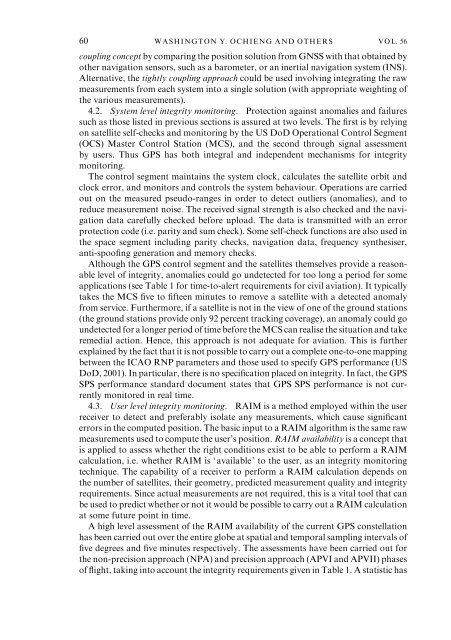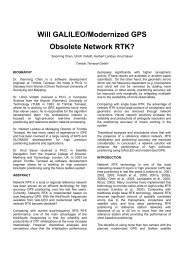GPS Integrity and Potential Impact on Aviation Safety - intelligent ...
GPS Integrity and Potential Impact on Aviation Safety - intelligent ...
GPS Integrity and Potential Impact on Aviation Safety - intelligent ...
Create successful ePaper yourself
Turn your PDF publications into a flip-book with our unique Google optimized e-Paper software.
60 WASHINGTON Y. OCHIENG AND OTHERS VOL. 56<br />
coupling c<strong>on</strong>cept by comparing the positi<strong>on</strong> soluti<strong>on</strong> from GNSS with that obtained by<br />
other navigati<strong>on</strong> sensors, such as a barometer, or an inertial navigati<strong>on</strong> system (INS).<br />
Alternative, the tightly coupling approach could be used involving integrating the raw<br />
measurements from each system into a single soluti<strong>on</strong> (with appropriate weighting of<br />
the various measurements).<br />
4.2. System level integrity m<strong>on</strong>itoring. Protecti<strong>on</strong> against anomalies <str<strong>on</strong>g>and</str<strong>on</strong>g> failures<br />
such as those listed in previous secti<strong>on</strong>s is assured at two levels. The first is by relying<br />
<strong>on</strong> satellite self-checks <str<strong>on</strong>g>and</str<strong>on</strong>g> m<strong>on</strong>itoring by the US DoD Operati<strong>on</strong>al C<strong>on</strong>trol Segment<br />
(OCS) Master C<strong>on</strong>trol Stati<strong>on</strong> (MCS), <str<strong>on</strong>g>and</str<strong>on</strong>g> the sec<strong>on</strong>d through signal assessment<br />
by users. Thus <str<strong>on</strong>g>GPS</str<strong>on</strong>g> has both integral <str<strong>on</strong>g>and</str<strong>on</strong>g> independent mechanisms for integrity<br />
m<strong>on</strong>itoring.<br />
The c<strong>on</strong>trol segment maintains the system clock, calculates the satellite orbit <str<strong>on</strong>g>and</str<strong>on</strong>g><br />
clock error, <str<strong>on</strong>g>and</str<strong>on</strong>g> m<strong>on</strong>itors <str<strong>on</strong>g>and</str<strong>on</strong>g> c<strong>on</strong>trols the system behaviour. Operati<strong>on</strong>s are carried<br />
out <strong>on</strong> the measured pseudo-ranges in order to detect outliers (anomalies), <str<strong>on</strong>g>and</str<strong>on</strong>g> to<br />
reduce measurement noise. The received signal strength is also checked <str<strong>on</strong>g>and</str<strong>on</strong>g> the navigati<strong>on</strong><br />
data carefully checked before upload. The data is transmitted with an error<br />
protecti<strong>on</strong> code (i.e. parity <str<strong>on</strong>g>and</str<strong>on</strong>g> sum check). Some self-check functi<strong>on</strong>s are also used in<br />
the space segment including parity checks, navigati<strong>on</strong> data, frequency synthesiser,<br />
anti-spoofing generati<strong>on</strong> <str<strong>on</strong>g>and</str<strong>on</strong>g> memory checks.<br />
Although the <str<strong>on</strong>g>GPS</str<strong>on</strong>g> c<strong>on</strong>trol segment <str<strong>on</strong>g>and</str<strong>on</strong>g> the satellites themselves provide a reas<strong>on</strong>able<br />
level of integrity, anomalies could go undetected for too l<strong>on</strong>g a period for some<br />
applicati<strong>on</strong>s (see Table 1 for time-to-alert requirements for civil aviati<strong>on</strong>). It typically<br />
takes the MCS five to fifteen minutes to remove a satellite with a detected anomaly<br />
from service. Furthermore, if a satellite is not in the view of <strong>on</strong>e of the ground stati<strong>on</strong>s<br />
(the ground stati<strong>on</strong>s provide <strong>on</strong>ly 92 percent tracking coverage), an anomaly could go<br />
undetected for a l<strong>on</strong>ger period of time before the MCS can realise the situati<strong>on</strong> <str<strong>on</strong>g>and</str<strong>on</strong>g> take<br />
remedial acti<strong>on</strong>. Hence, this approach is not adequate for aviati<strong>on</strong>. This is further<br />
explained by the fact that it is not possible to carry out a complete <strong>on</strong>e-to-<strong>on</strong>e mapping<br />
between the ICAO RNP parameters <str<strong>on</strong>g>and</str<strong>on</strong>g> those used to specify <str<strong>on</strong>g>GPS</str<strong>on</strong>g> performance (US<br />
DoD, 2001). In particular, there is no specificati<strong>on</strong> placed <strong>on</strong> integrity. In fact, the <str<strong>on</strong>g>GPS</str<strong>on</strong>g><br />
SPS performance st<str<strong>on</strong>g>and</str<strong>on</strong>g>ard document states that <str<strong>on</strong>g>GPS</str<strong>on</strong>g> SPS performance is not currently<br />
m<strong>on</strong>itored in real time.<br />
4.3. User level integrity m<strong>on</strong>itoring. RAIM is a method employed within the user<br />
receiver to detect <str<strong>on</strong>g>and</str<strong>on</strong>g> preferably isolate any measurements, which cause significant<br />
errors in the computed positi<strong>on</strong>. The basic input to a RAIM algorithm is the same raw<br />
measurements used to compute the user’s positi<strong>on</strong>. RAIM availability is a c<strong>on</strong>cept that<br />
is applied to assess whether the right c<strong>on</strong>diti<strong>on</strong>s exist to be able to perform a RAIM<br />
calculati<strong>on</strong>, i.e. whether RAIM is ‘available’ to the user, as an integrity m<strong>on</strong>itoring<br />
technique. The capability of a receiver to perform a RAIM calculati<strong>on</strong> depends <strong>on</strong><br />
the number of satellites, their geometry, predicted measurement quality <str<strong>on</strong>g>and</str<strong>on</strong>g> integrity<br />
requirements. Since actual measurements are not required, this is a vital tool that can<br />
be used to predict whether or not it would be possible to carry out a RAIM calculati<strong>on</strong><br />
at some future point in time.<br />
A high level assessment of the RAIM availability of the current <str<strong>on</strong>g>GPS</str<strong>on</strong>g> c<strong>on</strong>stellati<strong>on</strong><br />
has been carried out over the entire globe at spatial <str<strong>on</strong>g>and</str<strong>on</strong>g> temporal sampling intervals of<br />
five degrees <str<strong>on</strong>g>and</str<strong>on</strong>g> five minutes respectively. The assessments have been carried out for<br />
the n<strong>on</strong>-precisi<strong>on</strong> approach (NPA) <str<strong>on</strong>g>and</str<strong>on</strong>g> precisi<strong>on</strong> approach (APVI <str<strong>on</strong>g>and</str<strong>on</strong>g> APVII) phases<br />
of flight, taking into account the integrity requirements given in Table 1. A statistic has



